engine AUDI A4 2015 Repair Manual
[x] Cancel search | Manufacturer: AUDI, Model Year: 2015, Model line: A4, Model: AUDI A4 2015Pages: 304, PDF Size: 74.86 MB
Page 201 of 304
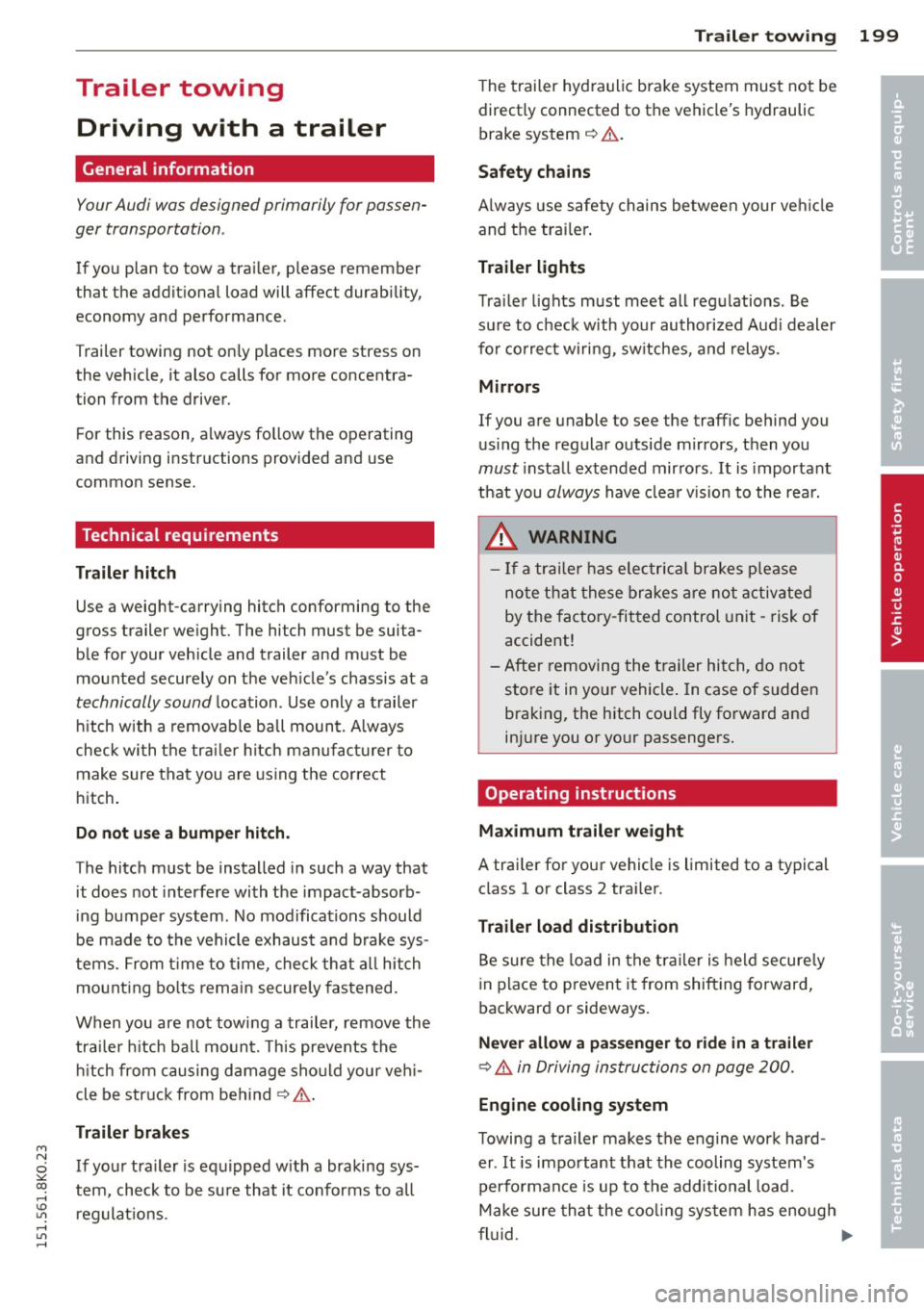
'"" N
0 ::.,: co ,...., \!) ..,.,
,...., ..,., ,....,
Trailer towing Driving with a trailer
General information
Your Audi was designed primarily for passen
ger transportation .
If you plan to tow a tra iler, p lease remember
that the addit ional load will affect durab ility,
economy and performance .
T railer towing not on ly places more stress on
the vehicle, it also calls for more concentra
tion from the driver.
F or this reason, a lways fo llow the operating
and driving instructions provided and use
common sense.
Technical requirements
Traile r hitch
Use a weight-carrying hitch conforming to the
gross trailer we ight. The hitch must be suita
b le for your veh icle and trailer and must be
mounted secure ly on t he veh icle's chassis at a
technically sound location . Use only a t railer
h itch w ith a removab le ball moun t. A lways
check with the tr ailer hitch man ufac tur er to
make sure that you are using the correct
hitch.
Do not use a bumper hitch.
T he hitc h must be installed in such a way that
it does not inte rfe re with the impac t-absorb
i ng b umper syst em. No modifica tions should
be made to the vehicle exhaus t and b rake sys
tems . From t ime to time, check that a ll hitch
mo unt ing bolt s remain securely fas tened.
W hen you are not tow ing a trailer, remove the
trai le r hi tch ball moun t. T h is prevents the
hi tch from causing damage sho uld your ve hi
cle be str uck from be hind
¢ &. .
Trailer brakes
If yo ur tra iler is equ ipped w it h a braking sys
tem, check to be su re that it conforms to a ll
r eg ulat io ns .
Trailer towin g 199
The trailer hyd ra ulic bra ke system must not be
direct ly connected to the vehicle's hydraulic
brake system
¢ &. .
Safety chains
Alw ays use s afety chains between your ve hicle
and t he tra ile r.
Trailer lights
Tra ile r lights m ust meet all reg ulations . Be
su re to check w ith your authorized Audi dealer
fo r c orrec t w iri ng, sw itches, and relays.
Mirrors
If you a re unable to see the traffic behind you
u sing the regula r outside m irrors, then you
must insta ll ext ended mir ro rs. It is important
t h at you
always have clea r vis io n to the rear .
.8, WARNING
- If a trai ler has elec trica l br ake s plea se
no te th at t hese bra kes are not activat ed
by the fa ctory -fit ted control unit -risk of
accident!
- After removing the t railer hi tch, do no t
s to re it in yo ur vehicle . In case of sudden
brak ing, the hitch could fly fo rward and
in ju re you or yo ur passenge rs .
Operating instructions
Maximum traile r we ight
-
A trai ler fo r you r vehicle is limited to a typical
class 1 or class 2 tra iler.
Trailer load distribution
B e sure the lo ad in the tra iler is h eld secure ly
i n p lace to p reven t it from shifting fo rward,
backward or sideways.
Never allow a passenger to ride in a trailer
¢ &. in Driving instru ctions on page 200.
Engine cooling system
T owing a t railer ma kes t he engine wor k hard
er . It is impo rta nt that the cooling system's
perfo rman ce is up to the additional load.
Make sure tha t the coo ling sys tem h as enough
f lu id . .,..
•
•
Page 202 of 304

200 Trailer towing
Tire pressure
When towing a trai le r, inflate the tir es of your
vehicle to the cold tire pressure listed under
"Full load" on the label located on the driver 's
side B-pillar (visible when the door is open).
Inflate trailer tires to trailer and tire manufac
turers' specifications.
Lights
The headlight settings should be checked with
the trailer attached before dr iving off. Check
to make sure both vehicle and tra iler lights
are working properly.
Safety chains
Be sure trailer safe ty cha ins are properly con
nected from the trailer to the hitch on the ve
hicle. Leave eno ugh slack in the chains to per
mit turning corners. When you install safety
cha ins, make sure they w ill not drag on the
road when you are driving.
The chains shou ld cross under the trai ler
tongue to prevent it from dropping in case of
separation from the hitch.
Driving instructions
Driving with a trailer always requires extra
care and consideration.
To obtain the best possible handling of vehicle
and trai ler, p lease note the following:
.,. Do not tow a loaded trailer when your car it
self is not loaded .
.,. Be especia lly careful when passing other
vehicles .
.,. Observe speed limits .
.,. Do not drive at the maximum permissible
speed.
.,. Always apply brakes early.
.,. Monitor the temperature gauge.
Weight distribution
Towing a loaded trai ler with an empty car re
sults in a highly unstable distribution of
weight . If this cannot be avo ided, drive at very
low speeds only to avoid the risk of losing
steering control. A "ba
lanced" rig is easier to operate and con
tro l. This means that the tow vehicle should
be loaded to the extent possible and permissi
ble, while keep ing the trai ler as light as possi
ble under the c ircumstances. Whenever poss i
ble, transfer some cargo to the luggage com
partment of the tow veh icle while obse rving
tongue load requi rements and vehicle load ing
considerations.
Speed
The higher the speed, the more d iff icu lt it be
comes for the driver to control the rig. Do not
drive at the maximum permissible speed. Re
duce your speed even more if load, weather or
wind conditions are unfavorable -pa rticularly
whe n going downhill.
Reduce veh icle speed
immediately if the trail
er shows the slightest s ign of sway ing.
Do not
try to stop the swaying by accelerating.
Observe speed limits . In some areas, speeds
for vehicles tow ing tra ilers are lower than for
regular vehicles .
Always apply brakes early. When driving
downh ill, shift into a lower gear to use the en
gine braking effect to slow the vehicle. Use of
the brakes alone can cause them to overheat
and fail.
Coolant temperature
The coolant temperature gauge c> page 10
must be observed carefully . If the needle
moves close to the upper end of the scale, re
duce speed immediately and/or turn off the
air conditioner.
If the coolant temperature warning light •
i n the i nstrument cluster starts flashing, pull
off the road, stop and let the engine
idle for
abo ut two minutes to prevent heat build-up .
_& WARNING
Anyone not properly restrained in a mov
ing vehicle is at a much greater risk in an
accident . Never let anyone ride in your car
who is not p roper ly wea ring the restraints
provided by Audi.
-
Page 209 of 304
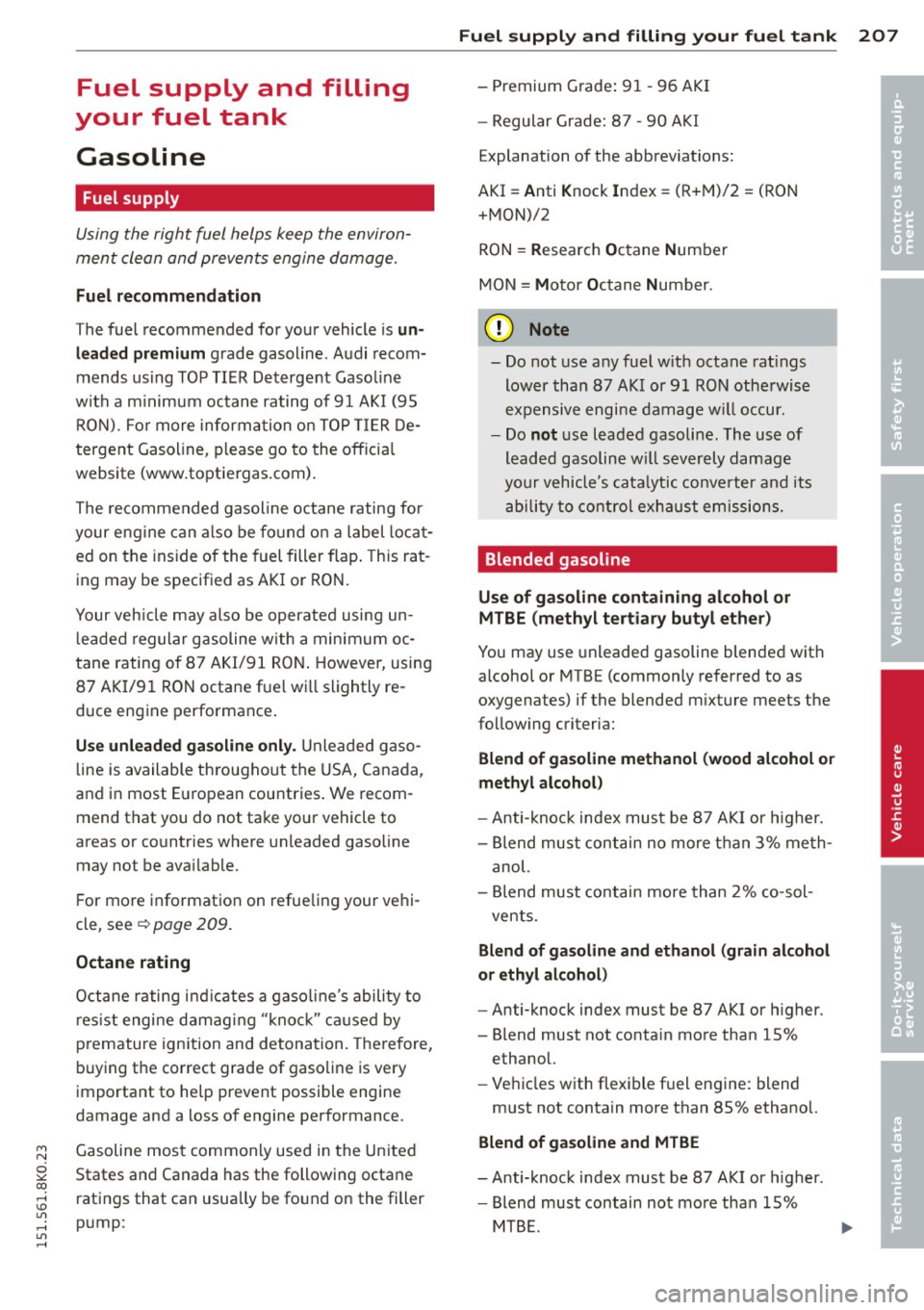
'"" N
0 ::.,: co ,...., \!) 1.1'1 ,...., 1.1'1 ,....,
Fuel supply and filling
your f uel tank
Gasoline
Fuel supply
Using the right fuel helps keep the environ
ment clean and prevents engine damage.
Fuel recommendation
The fuel recommended for you r vehicle is un
l e aded premium
g rade gasoline. A udi recom
mends using TOP TIER De tergent Gaso line
w ith a m inimum octane ra ting of 91 A KI (95
RON) . Fo r more informa tion on TOP TIER De
tergent Gasoline, please go to the off ic ial
website (www.toptie rgas .com) .
The re commended gasoline octane rating for
your eng ine can also be fo und o n a label loca t
ed on t he ins ide of the fuel filler flap . This ra t
ing may be specif ied as AKI or RO N.
Your veh icle may also be operated using un
l e aded regular g asoline w ith a min imum o c
tane rating of 87 AKI/91 RO N. However, using
87 AK I/91 RON octa ne fue l w ill sli ghtly re
d uce eng ine perfo rmance .
Use unleaded ga solin e only. Unleaded g aso
line is available th rougho ut the USA, Ca nada,
and i n most E uropean countries . We recom
mend that you do not ta ke yo ur vehicle to
areas or co untries where unleaded gasoline
may not be ava ilable.
F or mo re information on refue ling your ve hi
cle, see~
page 209.
Octane rating
Octane rati ng ind icates a gaso line's abili ty to
r es is t engi ne da maging "knoc k" ca use d by
p remature ign ition and detona tion. Therefore,
buying the correct grade of gaso line is very
i mportant to he lp prevent possible engine
damage and a loss o f engine performance .
Gasoline mos t common ly used in the Unite d
States an d Canada has the following octane
ratings that ca n usually be fo und on the filler
pump :
Fuel supply and filling your fuel tank 207
-Premium Grade: 9 1 -96 AKI
- Regular Grade: 87 -90 AKI
Explanation of the abb reviations :
AKI = Anti Knock Index = (R+ M)/2 = (RO N
+ MON)/2
RON = Research Octane Num ber
MON= Motor Octane Number.
@ Note
- Do not use a ny fue l w ith octane rat ings
lower than 87 AKI or 9 1 RO N othe rwise
expensive engi ne damage w ill occu r.
- Do
not use leaded gasoli ne. The use of
leade d gasoline w ill severely damage
yo ur vehicle's cata ly tic co nve rter and i ts
a bili ty to con trol exh aust emi ssion s.
Blended gasoline
Use of gasoline containing alcohol or
MTBE (methyl tertiary butyl ether )
You may use unleaded gasoline blende d with
alcohol or MTB E (commonly referred to as
oxygenates) if the blended m ixture meets the
fo llow ing criter ia:
Blend of gasoline methanol (wood alcohol or
methyl alcohol )
-Anti -knoc k index mus t be 87 A KI or higher.
- Blend mus t contain no more t han 3% me th -
a nol.
- Blend must contain more than 2% co-sol-
vents.
Blend of gasoline and ethanol (grain alcohol
or ethyl alcohol)
- Anti-knock index must be 87 AKI or higher.
- Blend must not conta in more than 15%
ethanol.
- Ve hicles w ith flexibl e fu el e ngine : blend
m ust not contain more than 85% ethanol.
Blend of gasoline and MTBE
- Anti-knoc k index must be 87 A KI or higher.
- Blend must contain no t mo re tha n 15%
MTBE.
•
•
Page 210 of 304
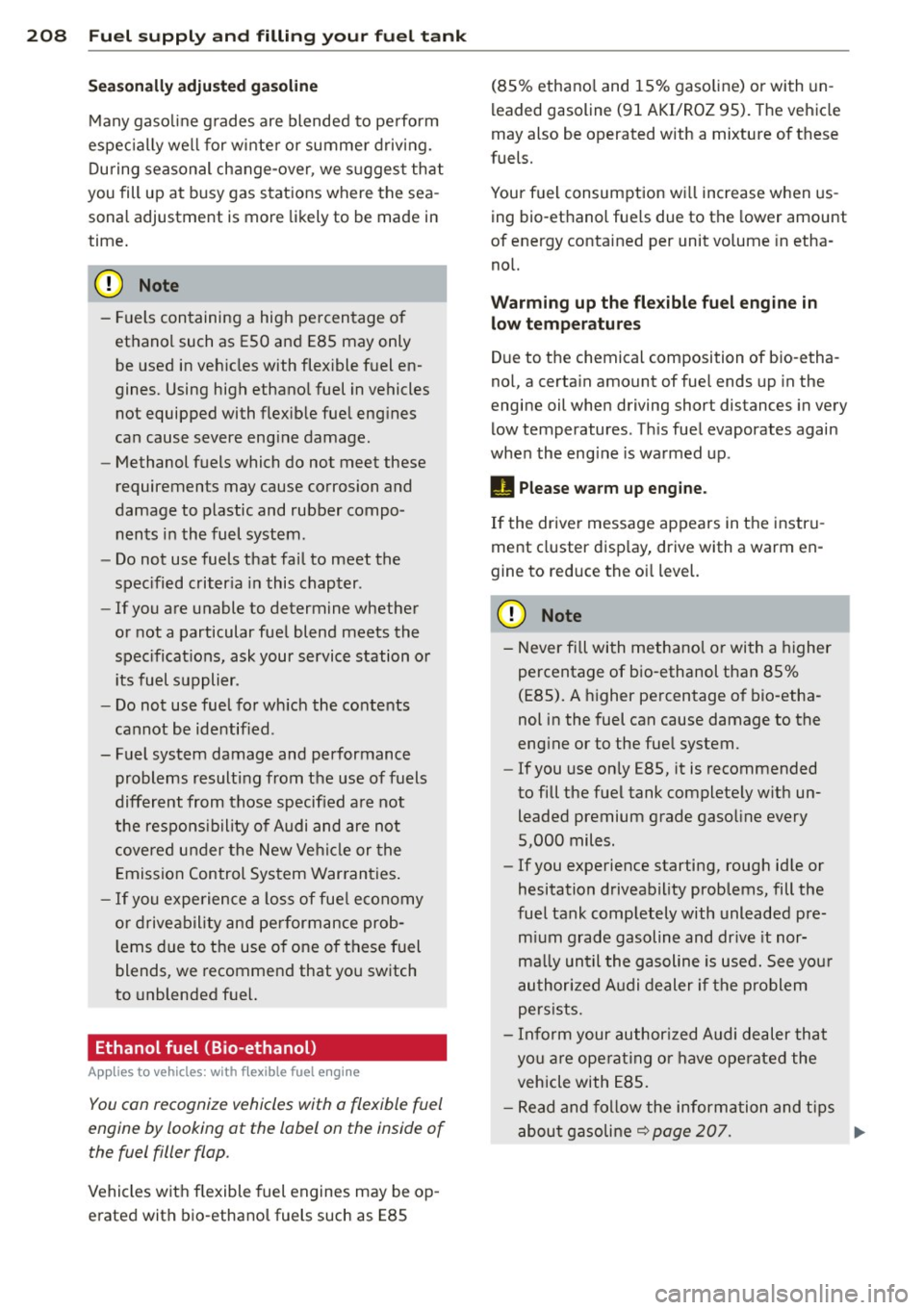
208 Fuel supply and filling your fuel tank
Seasonally adjusted gasoline
Many gasoline grades are blended to perform
especially well for winter or summer driving. During seasonal change-over, we suggest that
you fill up at busy gas stations where the sea
sonal adjustment is more likely to be made in
time.
CD Note
- Fuels containing a high percentage of
ethanol such as ESO and E85 may only be used in vehicles with flexible fuel en
gines. Using high ethanol fuel in vehicles not equipped with flexible fuel engines
can cause severe engine damage.
- Methanol fuels which do not meet these
requirements may cause corrosion and
damage to plastic and rubber compo
nents in the fuel system.
- Do not use fuels that fail to meet the
specified criteria in this chapter .
- If you are unable to determine whether
or not a particular fuel blend meets the
specifications, ask your service station or
its fuel supplier .
- Do not use fuel for which the contents
cannot be identified.
- Fuel system damage and performance
problems resulting from the use of fuels
different from those specified are not
the responsibility of Audi and are not
covered under the New Vehicle or the
Emission Control System Warranties.
- If you experience a loss of fuel economy
or driveability and performance prob
lems due to the use of one of these fuel
blends, we recommend that you switch
to unblended fuel.
Ethanol fuel (Bio -ethanol)
App lies to vehicles: with flexible fuel e ngi ne
You con recognize vehicles with a flexible fuel
engine by looking at the label on the inside of the fuel filler flap.
Vehicles with flexible fuel engines may be op
erated with bio-ethanol fuels such as E85 (8S% ethanol and
15% gasoline) or with un
leaded gasoline (91 AKI/ROZ 95). The vehicle
may also be operated with a mixture of these
fuels.
Your fuel consumption will increase when us
ing bio-ethanol fuels due to the lower amount
of energy contained per unit volume in etha
nol.
Warming up the flexible fuel engine in low temperatures
Due to the chemical composition of bio-etha
nol, a certain amount of fuel ends up in the
engine oil when driving short distances in very
low temperatures . This fuel evaporates again
when the engine is warmed up.
II Please warm up engine.
If the driver message appears in the instru
ment cluster display, drive with a warm en
gine to reduce the oil level.
CD Note
- Never fill with methanol or with a higher
percentage of bio-ethanol than 85%
(E85). A higher percentage of bio-etha
nol in the fuel can cause damage to the
engine or to the fuel system .
-If you use only E85, it is recommended
to fill the fuel tank completely with un
leaded premium grade gasoline every
5,000 miles .
- If you experience starting, rough idle or
hesitation driveability problems, fill the
fuel tank completely with unleaded pre mium grade gasoline and drive it nor
mally until the gasoline is used. See your
authorized Audi dealer if the problem
persists.
- Inform your authorized Audi dealer that
you are operating or have operated the
vehicle with E85.
- Read and follow the information and tips
about gasoline
c::> page 207. .,.
Page 211 of 304
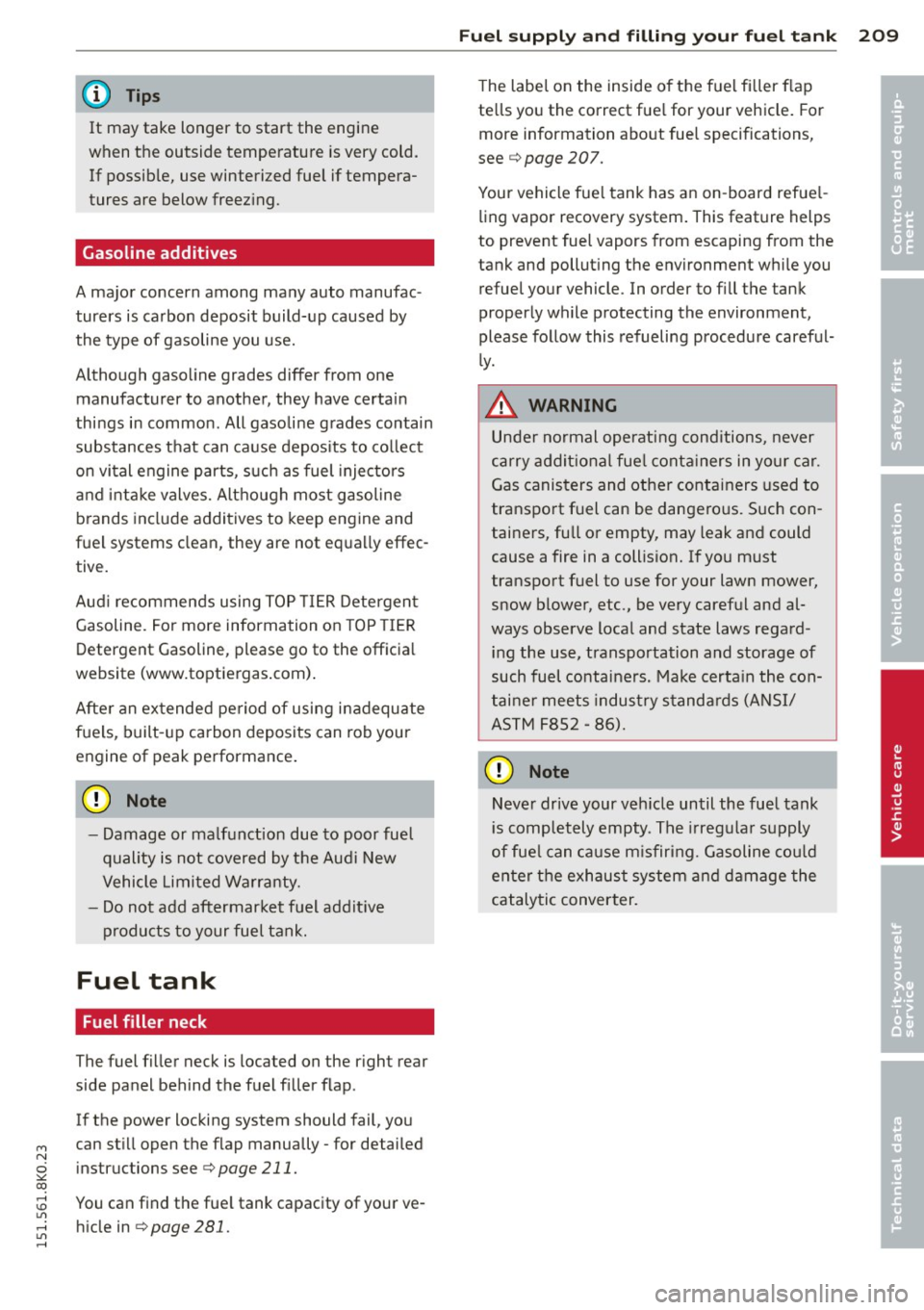
"" N
0 ::.,: co ,...., \!) 1.1'1 ,...., 1.1'1 ,....,
@ Tips
It may take longer to start the engine
when the outside temperature is very cold.
If possible, use winterized fuel if tempera
tures are below freezing.
Gasoline additives
A major concern among many auto manufac
turers is carbon deposit build-up caused by
the type of gasoline you use.
Although gasoline grades differ from one manufacturer to another, they have certain
things in common. All gasoline grades contain
substances that can cause deposits to collect
on vital engine parts, such as fuel injectors
and intake valves. Although most gasoline
brands include additives to keep engine and
fuel systems clean, they are not equally effec
tive.
Aud i recommends using TOP TIER Detergent
Gasoline. For more information on TOP TIE R
Detergent Gasoline, please go to the officia l
website (www.toptiergas .com) .
Afte r an extended pe riod of using inadequate
fuels, built-up carbon deposits can rob your
engine of peak performance.
CD Note
- Damage or malfunction due to poor fuel
quality is not covered by the Audi New
Vehicle Limited Warranty.
- Do not add aftermarket fuel additive
products to your fuel tank.
Fuel tank
Fuel filler neck
The fuel filler neck is located on the r ight rear
side panel behind the fuel filler flap.
If the power locking system should fail, you
can sti ll open the flap manually - for detailed
instructions see
c:> page 211.
You can find the fue l tank capacity of your ve
hicle in
c:> page281.
Fuel supply and filling your fuel tank 209
The label on the inside of the fuel fi lier f lap
te lls you the correct fue l for your vehicle. For
more information about fuel specifications,
see
c:> page 207.
Your vehicle fue l tank has an on -board refue l
ling vapor recovery system. This feature helps
to prevent fuel vapors from escaping from the
tank and polluting the environment while you
refuel your vehicle. In order to fill the tank
proper ly while protecting the environment,
please follow this refueling procedure careful
ly.
_&. WARNING
Under normal operating conditions, never
carry additional fuel containers in your car.
Gas canisters and other containers used to
transport fuel can be dangerous. Such con
tainers, fu ll or empty, may leak and could
cause a fire in a collision. If you must
transport fuel to use for your lawn mower,
snow blower, etc., be very careful and al
ways observe local and state laws regard
ing the use, transportation and storage of
such fuel containers. Make certain the con
tainer meets industry standards (ANSI/
ASTM F852 - 86).
CD Note
Never drive your veh icle until the fuel tank
i s completely empty. The irregu la r supply
of fue l can cause misfiring. Gasoline cou ld
enter the exhaust system and damage the
catalytic converter.
•
•
Page 212 of 304
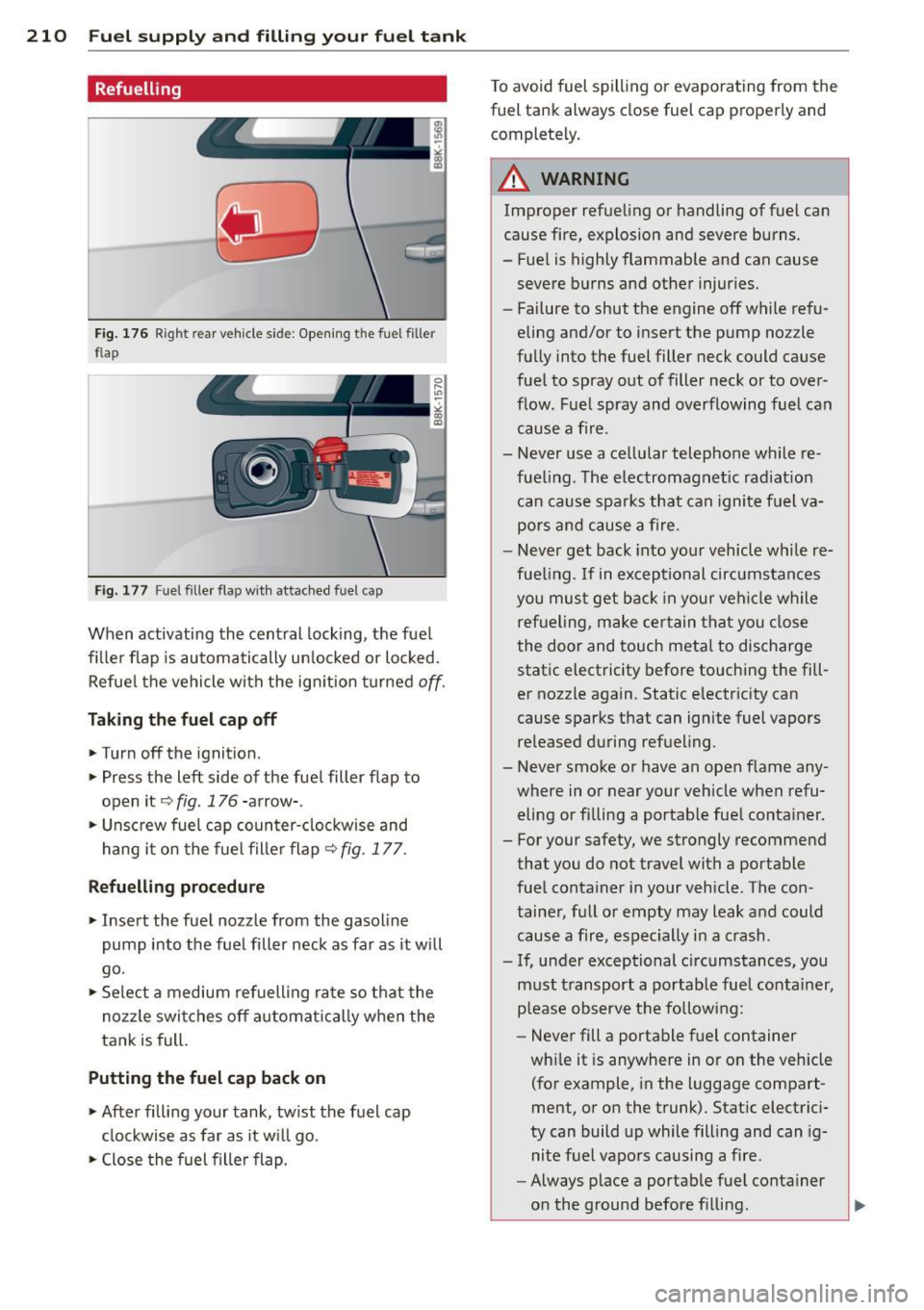
210 Fuel supply and filling your fuel tank
Refuelling
Fig. 176 Right rear vehicle side: Open ing t he fuel filler
flap
F ig. 177 Fu el filler flap with attached fuel cap
When activating the central lock ing, the fuel
fi ller flap is automatically un locked or loc ked.
Refuel the vehicle with the ig nition turned
off.
Taking the fuel cap off
~Turnoff the ignition .
~ Press the left side of the fuel filler flap to
open it
c::> fig. 176 -arrow- .
~ Unscrew fuel cap counter-clockwise and
hang it on the fuel filler flap
~ fig. 177.
Refuelling procedure
~ Insert the fuel nozzle from the gasoline
pump into the fuel filler neck as far as it will
go.
~ Select a medium refuelling rate so that the
nozzle switches off a utomatica lly when the
tank is full.
Putting the fuel cap back on
~ After filling your tank, tw ist the fuel cap
clockwise as far as it will go.
~ Close the fuel filler flap. T
o avoid fuel spilling or evaporating from the
fuel tank always close fuel cap properly and
completely .
A WARNING
-Im proper refueling or handling of fuel can
cause fire, explosion and severe burns.
- Fuel is highly flammable and can cause
severe burns and other injuries.
- Failure to shut the engine off while refu
eling and/or to insert the pump nozzle
fully into the fuel filler neck could cause
fuel to spray out of filler neck or to over
flow. Fuel spray and overflowing fuel can cause a fire .
- Never use a cellular telephone while re
fueling. The electromagnet ic rad iat ion
can cause sparks that can ignite fuel va
pors and cause a fire.
- Never get back into your vehicle whi le re
fue ling.
If in exceptional circumstances
you must get back in your vehi cle while
refueling, make ce rtain that you close
the door and touch metal to discharge
static electricity before touching the fill
er nozzle again. Static electricity can
cause sparks that can ignite fuel vapors released during refueling.
- Never smoke or have an open flame any
where in or near your vehicle when refu
eling or filling a portable fuel conta iner.
- For your safety, we strongly recommend
that you do not travel with a portable
fuel conta iner in your vehicle . The con
tainer, full or empty may leak and could
cause a fire, especially in a crash.
- If, u nder exceptional cir cumstances, you
must transport a portable fuel conta iner,
p lease observe the following:
- Never fill a portable fuel container
whi le it is anywhere in or on the vehicle
(for example, in the luggage compart
ment, or on the trunk). Static electrici
ty can build up while filling and can ig
nite fuel vapors causing a fire .
- Always place a portable fue l conta iner
on the ground before filling.
Page 213 of 304

M N
~ co
rl I.O
"' rl
"' rl
-Always keep the f iller nozzle complete
ly inside the portable conta iner before
and during filling.
- If filling a portable container made of
metal, the filler nozz le must always be
in contact with the container. Th is w ill
he lp prevent static electricity from dis
charg ing and cause a fire .
- Never sp ill fuel inside the vehicle or
luggage compartment. Fue l vapors are
h ighly f lammable .
- Always observe local and state/provin cial laws regarding the use, storage
and tra nspo rta tion of fuel containers.
- Make certa in the fuel conta iner meets
industry standards (A NSI
I ASTM
F852-86).
(D Note
If any fuel has spilled onto the car, it
should be removed immediate ly to prevent
damage to the paint.
@ For the sake of the environment
As soon as the correctly operated nozzle
sw itches off automatically for the fi rs t
time, the tank is full. Do not try to add
more f ue l because fuel may spill out. In
add it ion , the expans io n s pace in the fuel
t ank will be fi lled -ca using the fue l to
overflow when it becomes warm and pol
lute the env iro nment.
@ Tips
- Runn ing yo ur engine while re fuelling
may ca use vapors to escape o r even
ca use fue l to spill out of the tank . This
would then shut off the fuel nozzle be
fo re the tank is fu ll.
- Do not refuel your ve hicle w ith the igni
tion t urned on. The fuel gauge may oth
erwise not ind icate the correct fue l level
after refuel ling.
- The fuel filler flap of your vehicle is not locked when you lock the vehicle from
the i nside.
Fu el suppl y and filli ng your fuel t ank 211
Unlocking the fuel filler flap by hand
You can open the fuel filler flap by hand if the
power loc king system should fail .
Fig. 1 78 Sedan L uggage compartment: ope ning the
si de t rim
Fig. 17 9 Luggage com partme nt: Eme rge ncy o pen ing
of fue l
fi lier flap
The emergency opening mechanism is located
behind the r ight side trim panel in the l ug
gage comp artment .
Opening the side trim
.,.. Sedan: Insert a tool such as a sc rewdriver
<=:> page 260 o r the emergency key into the
r ight side of the upper gap ¢
fig. 178.
.... Sedan: Pry upwar d to release the trim.
.,.. allroad: Open the rig ht side trim pane l.
Fuel filler door emergency release
.,.. Loosen the st rap from its bracket and p ull
on it
i=:> fig . 179 . You can now op en the fuel
filler flap as usual ¢
page 210.
Page 214 of 304
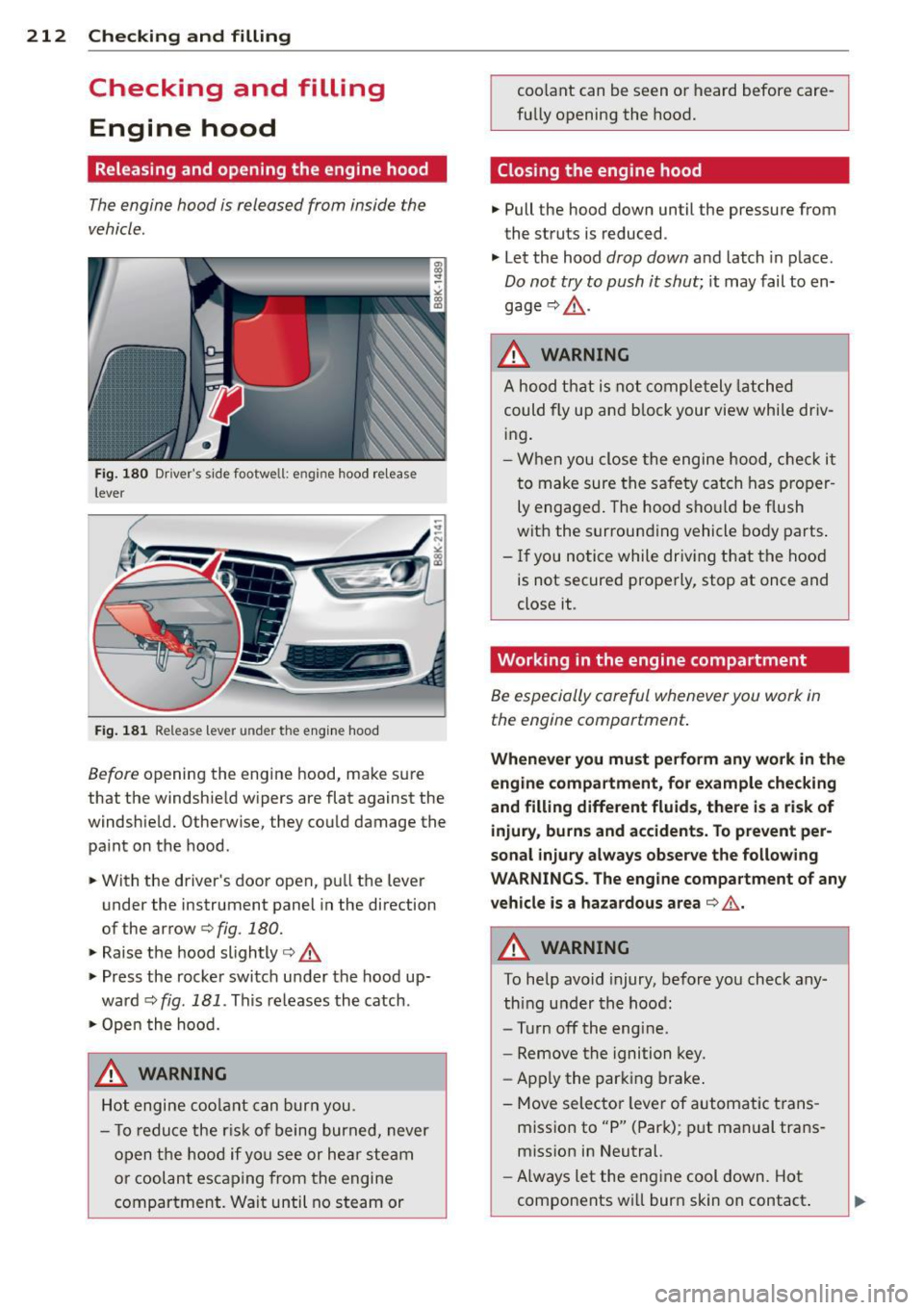
212 Checking and filling
Checking and filling
Engine hood
Releasing and opening the engine hood
The engine hood is released from inside the
vehicle .
Fig. 180 Driver's side footwe ll: e ngin e hood release
lever
... -- - -=-
Fig. 181 Release lever u nde r the engine hood
Before opening the engine hood, make sure
that the windshield wipers are flat against the
windshield. Otherwise, they could damage the
pa int on the hood.
... With the driver's door open, pull the lever
under the instrument panel in the direction
of the arrow
c> fig . 180.
... Raise the hood slightly c> .&,
... Press the rocker switch under the hood up
ward
c> fig . 181 . This releases the catch.
... Open the hood.
A WARNING
Hot engine coo lant can burn you.
- T o reduce the risk of being burned, never
open the hood if you see or hear steam
or coolant escaping from the engine
compartment. Wait until no steam or coo
lant can be seen or heard before care
fully opening the hood.
Closing the engine hood
... Pull the hood down until the pressure from
the struts is reduced .
... Let the hood
drop down and latch in place.
Do not try to push it shut; it may fail to en
gage
c> .&, .
A WARNING
-
A hood that is not completely latched
could fly up and b lock your view while driv
ing.
- When you close the engine hood, check it
to make sure the safety catch has proper
ly engaged . The hood shou ld be flush
with the surrounding vehicle body parts.
-If you notice while driving that the hood
is not secured properly, stop at once and
close it.
Working in the engine compartment
Be especially careful whenever you work in
the engine compartment.
Whenever you must perform any work in the
engine compartment, for example checking
and filling different fluids , there is a risk of
injury , burns and accidents. To prevent per
sonal injury always observe the following
WARNINGS. The engine compartment of any
vehicle is a hazardous area
c> ,&..
A WARNING
-To help avoid injury, before you check any-
thing under the hood:
- Turn off the engine.
- Remove the ignition key.
- Apply the parking brake.
- Move selector lever of automatic trans-
mission to "P" (Park); put manual trans
mission in Neutral.
- Always let the engine cool down. Hot
components will burn skin on contact .
Page 215 of 304
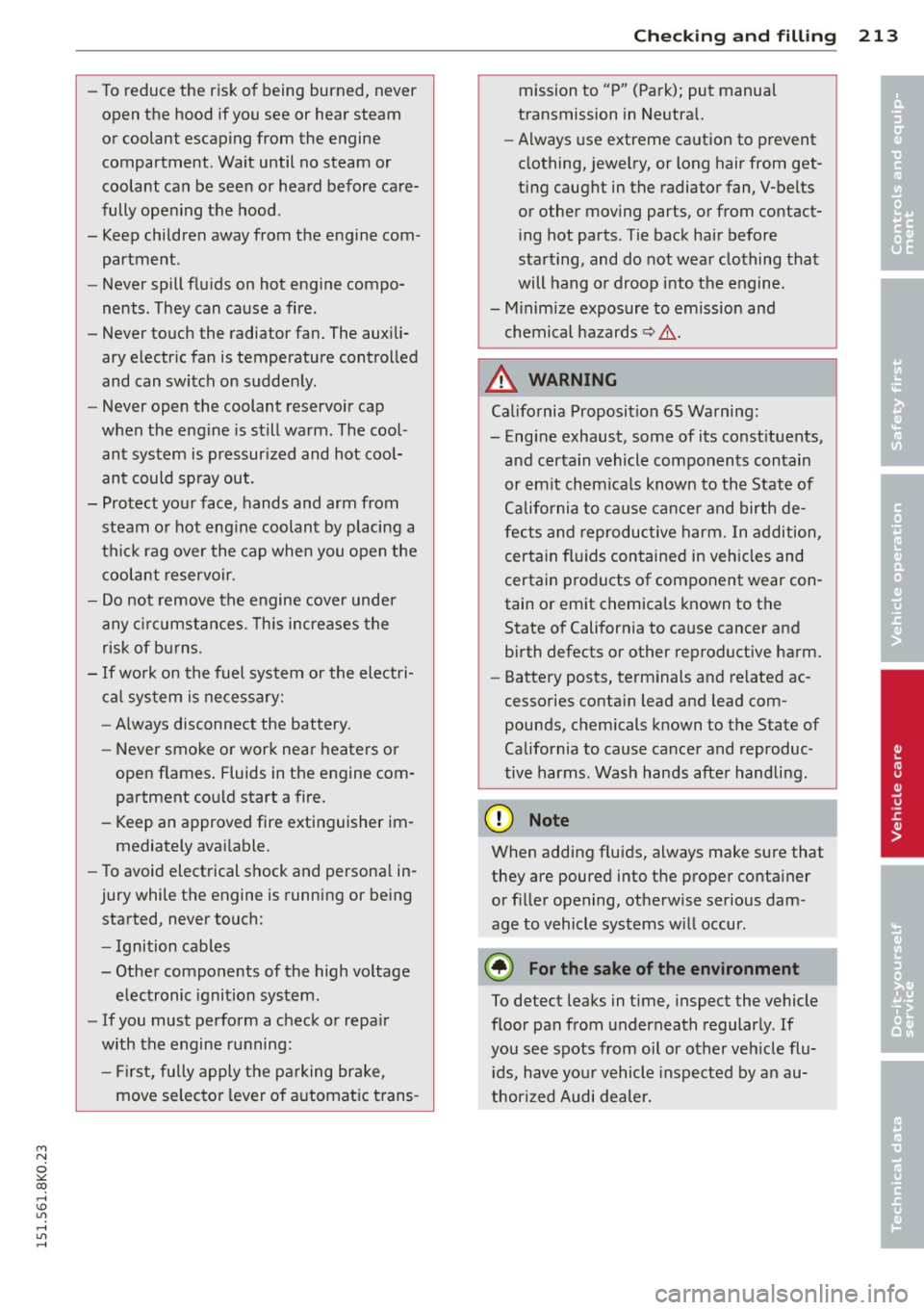
"" N
0 ::.,: co ,...., \!) ..,.,
,...., ..,., ,....,
-To reduce the r isk of being burned, never
open the hood if you see or hear steam
or coolant escaping from the engine
compartment . Wait until no steam or
coolant can be seen or heard before ca re
fully opening the hood .
- Keep children away from the engine com
partment.
- Never spill flu ids on hot engine compo
nents. They can cause a fire .
- Never touch the radiator fan. The aux ili
ary e lectr ic fan is temperature controlled
and can switch on suddenly .
- Never open the coolant reservoir cap
when the eng ine is still warm . The cool
ant system is pressur ized and hot coo l
ant could spray out.
- Protect your face, hands and arm from
steam or hot eng ine coolant by placing a
thic k rag over the cap when you open the
coolant reservoir.
- Do not remove the engine cover under
any c ircumstances. Th is increases the
risk of bu rns.
- If wo rk on the fuel system or the electri
cal sys tem is ne cessary:
- Always disconnect the battery.
- Never smoke or work near heaters or
open flames . Fluids in the engine com
partment co uld start a fire.
- Keep an approved fire extinguisher im
mediately ava ilable.
- To avoid electrical s hock and persona l in
jury while the engine is running or being
started, never touch:
- Ignition cables
- Other components of the high voltage
electronic ignition system.
- If you must perform a check or repa ir
with the engine running:
- Fir st, fully apply the parking brake,
move se lector lever of a utomatic trans-
Checkin g and fillin g 213
mission to "P" (Park); put manual
transmission in Neutral.
- Always use extreme caution to prevent
clothing, jewe lry, or long hair from get
ting caught in the radiator fan, V-be lts
or other moving parts, or from contact i ng hot parts . Tie back hair before
starting, and do not wear clothing that
will hang o r droop into the engine .
- Minimize exposure to emission and
chemical hazards~&. .
A WARNING
California Proposition 65 Warning:
- Engine exhaust, some of its const ituents,
a nd certain vehicle components contain
or emit chemicals known to the State of
Ca lifornia to cause cance r and birth de
fects and reproductive harm. In addition, certain fl uids contained in veh icles and
certain products of component wear con
tain or emit chemica ls known to the
State of California to cause cancer and
birth defects or other reproductive harm.
- Battery posts, terminals and related ac
cessories conta in lead and lead com
pounds, chemicals known to the State of
California to cause cancer and reproduc
tive harms. Wash hands afte r handling.
Q) Note
When adding f lu ids, always make sure that
they are poured into the proper conta iner
or f iller opening, otherwise serious dam
age to vehicle systems w ill occur .
@ For the sake of the environment
To detect leaks in time, inspect the vehicle
floor pan from underneath regular ly . If
you see spots from oil or other veh icle flu
i ds, have your vehicle inspected by an au
thorized Audi dealer. •
•
Page 216 of 304

214 Checking and filling
Engine compartment
Engine compartment
These are the most important items that you can check.
Fig. 182 Typical layout for containers and eng ine o il filler cap
(D Eng ine o il filler cap ("1::::r.) . . . . . 216
@ Jump start point(+) under a cov-
er .. .. .... ... ....... .... ..
224, 275
@ Bra ke fluid reservo ir (0)) . . . . . 221
@ Coolant expansion tank (-L) . . . 219
® Jump start point(-) with hex
head sc rew ..... .......... ..
224, 275
® W indshield/headlight* washer
. (" ') container o ....... . ... .. . 225
The pos ition o f the engine o il fi lling hole
¢ fig . 182 (item @) can differ depending on
the eng ine design.
A WARNING
Before yo u check anything in the engine
compartment, always read and heed all
WARNINGS
¢ .&. in Working in the engine
compartment on page 212.
-
Engine oil
· Engine oil specifications
The engine oil used must conform to exact
specifications.
The service interval disp lay in the instrument
cluster of your vehicle will inform you when it
is time for a n oil change . We recommend that
you have your oil changed by an authorized
Audi Se rv ice Adv isor.
If you have to top off the o il between o il
changes, use the Audi o il quality standard
specified in the tab le.
Audi oil quality standard
Gasoline
VW 502 00 or
engine vw 504 00